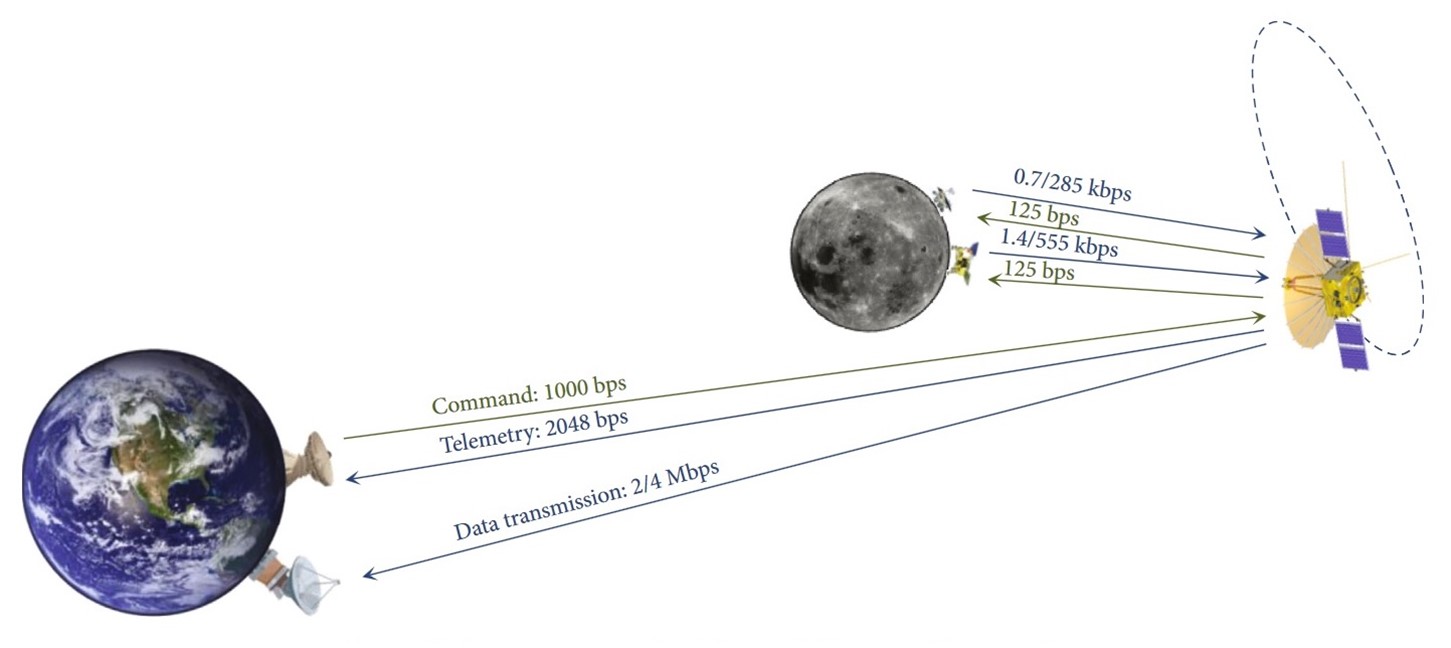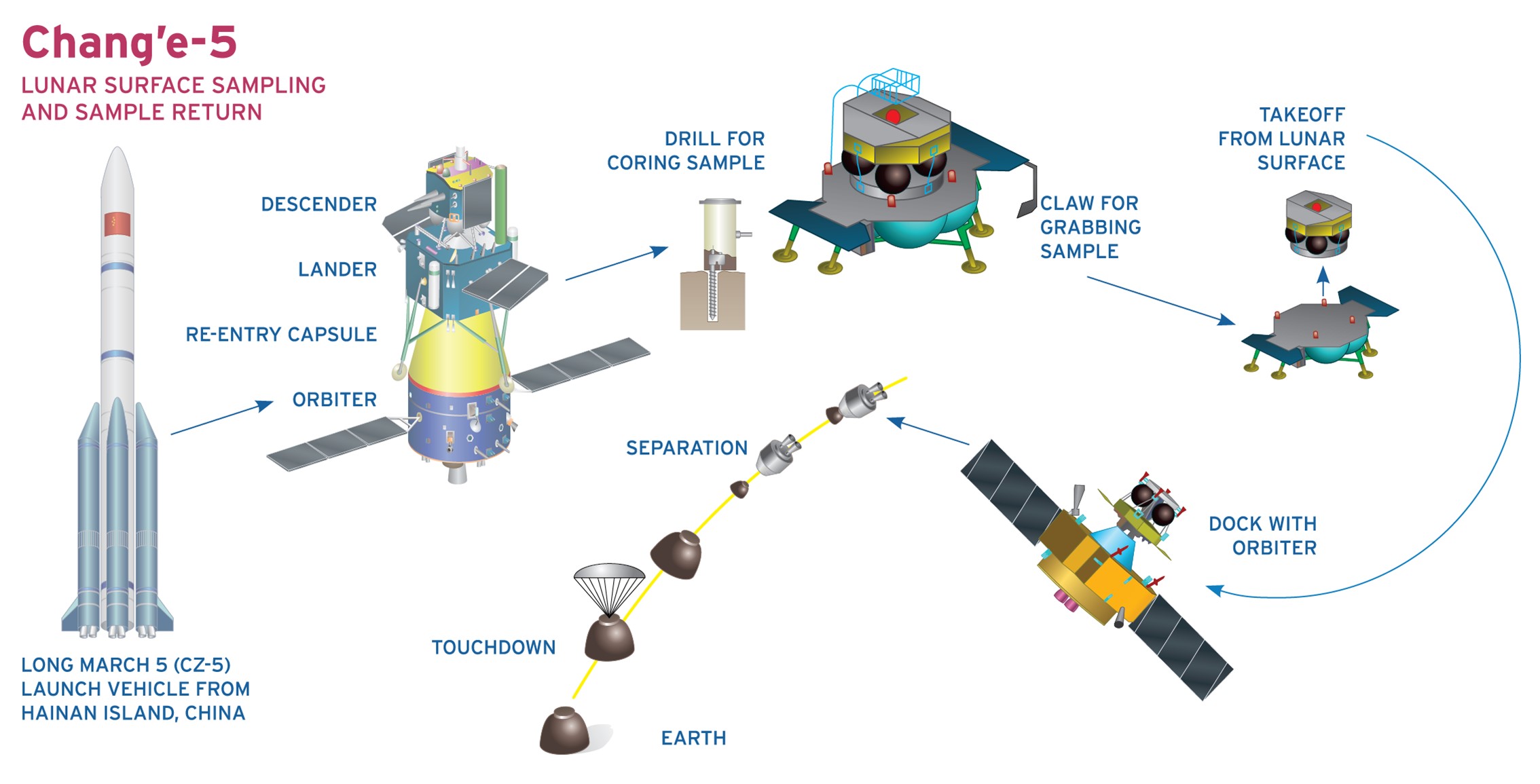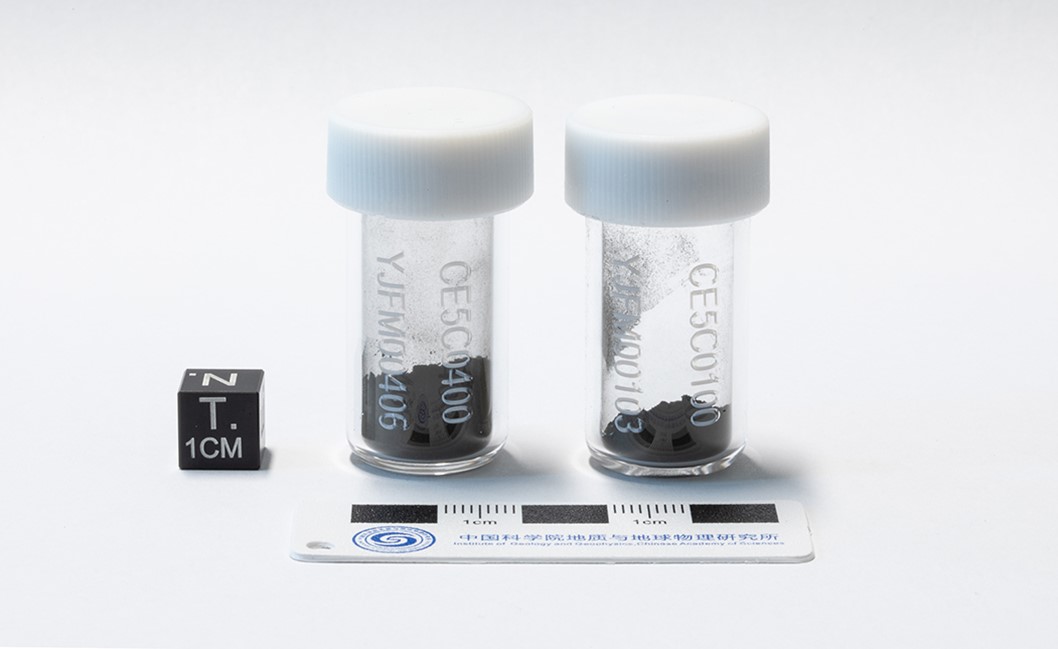
Credit: Tsukioka Yoshitoshi, public domain, via Wikimedia Commons
Background
Synopsis: China’s Chang’e lunar missions have pushed the boundaries of space exploration, from landing on the Moon’s far side to returning samples that are reshaping our understanding of lunar history. Overcoming extreme technological challenges, these missions have uncovered new insights into the Moon’s hidden past. The U.S. and China are both gearing up for crewed lunar landings, laying the groundwork for humanity’s future on the Moon and beyond.
The Moon has fascinated humans across time, civilizations, and cultures for man’s entire existence. An early EarthDate episode shared some of the folklore and myths about the Moon and explained why it is we always see the same side of the Moon’s surface. For the last twenty years, China has been exploring Earth’s nearest neighbor through a series of lunar missions named “Chang’e” that have explored both the near and far sides of the Moon.
- The Chinese Moon goddess is named Chang’e who, according to Chinese mythology, became immortal after drinking an elixir of everlasting life. She lives in the Moon Palace with her pet rabbit, Yu Tu, and is celebrated during the mid-Autumn Festival held on the 15th day of the 8th month of the Chinese lunisolar calendar with a full moon at night. This will be on October 6, 2025, September 25, 2026, and September 15, 2027.
- It was in honor of this moon goddess that the Chinese named their long-term lunar exploration program “Chang’e” with goals of conducting scientific research, testing new technologies, and paving the way for future crewed lunar missions.
- The first phase included orbital reconnaissance that involved lunar mapping and data collection.
- In 2007, the first lunar orbiter, Chang’e-1, created a high-resolution map of the Moon.
- Three years later, Chang’e-2 provided higher resolution imaging and selected a landing site for Chang’e 3. The mission also tested a new ground tracking system which operates in a region known as X-band which falls between 8-12 GHz, allowing for high data rates and precise tracking.
- In 2013, Chang’e-3 successfully made the first soft landing on the moon by China and deployed the Yutu-1 rover.
- The 2019 Chang’e-4 mission was one for the record books – a first-ever landing on the far side of the Moon. But first, a major technological challenge had to be overcome.
- The Chinese did not just want to land on the far side of the Moon, but they hoped to deploy the Yutu-2 rover, exploring this unknown moonscape.
- Mission controllers on Earth needed to communicate with and send commands to the lander and rover, but signals do not transmit to the opposite side of the Moon. The solution was a satellite.
- The Queqiao satellite is positioned in a special orbit about 65,000 km beyond the Moon at a point where it can always “see” both the far side of the Moon and Earth. This relay system allows commands to be sent back and forth between Earth, Queqiao-1, and the lander.
- This first-ever relay satellite was a major achievement in space exploration. Queqiao uses a large dish antenna (4.2 meters wide) to ensure clear communication, and runs on solar power, allowing it to stay operational for years.

A satellite named Queqiao was located beyond the Moon to provide communication between scientists on Earth and the Chang’e-4 lander and rover on the far side of the Moon. Queqiao means "Bridge of Magpies", referring to a Chinese folktale about magpies forming a bridge with their wings to allow Zhi Nü , the seventh daughter of the Goddess of Heaven, to reach her husband. The satellite was the needed “bridge” in the communication process.
Credit: Zhang Lihua/Dong Fang Hong Satelliten GmbH, CC BY 4.0, via Wikimedia Commons
- The next two Chang’e missions involved collecting samples from the lunar surface and returning them to Earth for analysis, the first samples from the Moon since the Soviet Luna 24 mission in 1976.
- Chang’e 5 landed on the Moon’s near side northwest corner in a dark grey region known as the Ocean of Storms in November of 2020.
- The spacecraft included a service module, lander, ascent vehicle, and an Earth return module.
- The service module and Earth return module remained in lunar orbit while the lander and ascent module descended to the surface.
- Reaching a depth of 2 meters, the lander used a robotic arm mechanical drill and scoop (another lunar first) to collect 1.7 kg (3.7 pounds) of lunar rock and dust.
- The lander also had several cameras to visually document the landing site and ground-penetrating radar to map below the surface.
- A spectrometer aboard was also employed to determine the mineral composition at the landing site which would aid in determining potential water content of the surface.
- After 14 Earth days, the ascent vehicle launched from the surface with the samples. The ascent vehicle reconnected to the service module and then samples were transferred to the Earth return module.
- The Earth return module was bounced off Earth’s atmosphere to slow it down in a move known as “skip reentry” before plunging to Earth, landing in Inner Mongolia.

The Chang’e-5 mission employed many technological advances, using a separate orbiter and lander, a robotic mechanical arm for drilling and sample collection, propelling the lander back to the orbiter, and safely returning the collected samples to Earth.
Credit: Loren Roberts, CC BY-SA 3.0, via Wikimedia Commons
- In May of 2024, Chang’e-6 underwent a similar mission with one big difference – it landed on the far side of the Moon.
- Using a more robust satellite communication system, Queqiao-2, the lander again collected rock samples (1.9 kg or 4.2 pounds) which were returned to Earth.
- The mission also included a secret rover that was deployed and surprised many observers when it sent an image of the Chang’e-6 lander.
- Other science experiments conducted included a radon detection device that was built by France.
- In a first for the European Space Agency, a device designed in Sweden detected the presence of negative ions on the surface. The ions form through interactions with the surface and solar wind, a flow of radiation and particles from the Sun. Positive, negative and neutral particles can result, but only positive ions had been detected before. Because negative ions remain near the surface, the instrument had to on the surface to collect data.
- “These observations on the Moon will help us better understand the surface environment and act as a pathfinder to explore negative ion populations in other airless bodies in the Solar System, from planets to asteroids and other moons,” explains Martin Wieser, principal investigator at the Swedish Institute for Space Physics.
- With the lunar samples back on Earth, scientists were excited to begin their analysis, and both sets of samples have provided some important new insights about the moon.
- Scientists studying Moon rocks found a brand-new mineral called Changesite in a sample from the near side of the Moon!
- The Moon is covered in craters from asteroids crashing into it. These crashes create super high heat and pressure, which can change the rocks on the surface.
- Scientists think Changesite formed when an asteroid hit the Moon about 2 billion years ago, making a crater between 2 and 20 miles wide.
- The sample also had two rare silica (sand-like) minerals called seifertite and stishovite. Normally, under extreme pressure, seifertite can turn into stishovite.
- A scientist studying the rocks said high-pressure minerals like these are rare on the Moon because they don’t last long at high temperatures.
- Finding these two minerals together in the same sample was a big surprise to scientists, and they are still trying to figure out how it happened!

Samples collected by the lander during the Chang’e-5 mission on the near side of the Moon. Both known and unknown minerals were found in the samples.
Credit: Hui Ren, CC BY 4.0, via Wikimedia Commons
- What had the scientific community most excited, however, were the samples returned from the Chang’e-6 far side mission.
- The Moon’s far side is very different from the side we see. It has more big craters and a thicker crust.
- The dark patches on the Moon’s surface made up of basalt come from volcanic lava. Much of it is on the side we see, but scientists found basalt on the far side too!
- Tests on these rocks show that volcanoes on the far side were active for at least 1.4 billion years.
- One super old sample was 4.2 billion years old, nearly the age of Earth, which helps scientists understand how the Moon changed over time.
- The rocks also gave scientists a surprise: they showed that the Moon’s magnetic field was stronger 2.8 billion years ago than scientists thought.
- Future Chang’e missions include further study of lunar geology and water in addition to developing in-situ resource utilization (ISRU). This is the process of using local material to support space exploration such as extracting water from rocks or building bricks from local soils. This type of technology is needed if humans are to establish outposts on the Moon and Mars. The Chinese are planning to have humans in space by 2030.
- NASA’s Commercial Lunar Payload Services program (CLPS) will deliver more science instruments to the Moon in 2025 and is planning to land astronauts on the Moon through the Artemis Missions, planned for 2026.
Episode script
The dark side of the moon isn’t really dark. It has a lunar day just like the near side. The far side just seems dark to us, because it faces away from Earth and we never see it.
US space missions never landed there, but China was determined to explore it. So, they began a multi-decade, unmanned lunar program, named after the Chinese moon goddess, Chang’e.
In 2007 and 2010, Chang’e 1 and 2 spacecrafts orbited and mapped the moon, to determine a landing spot on the near side for Chang’e 3, which successfully touched down in 2013.
But to put a craft on the far side, where radio signals could not reach to control it, took a monumental feat of engineering.
The Chinese first had to build and launch a radio relay satellite, a huge dish orbiting 40,000 miles beyond the moon, that could bounce signals from Earth.
With this in place, they launched Chang’e 4, which became the first spacecraft ever to land on the far side of the moon, in 2019.
The Chinese then launched a more robust Chang’e 6, which contained a large rover.
In 2024, it successfully explored the far side and returned with several pounds of moon rocks.
China’s moon missions have produced important new findings about the moon’s geologic history and magnetic fields, and discovered a new mineral not found on Earth -- which they named of course, Changesite.

